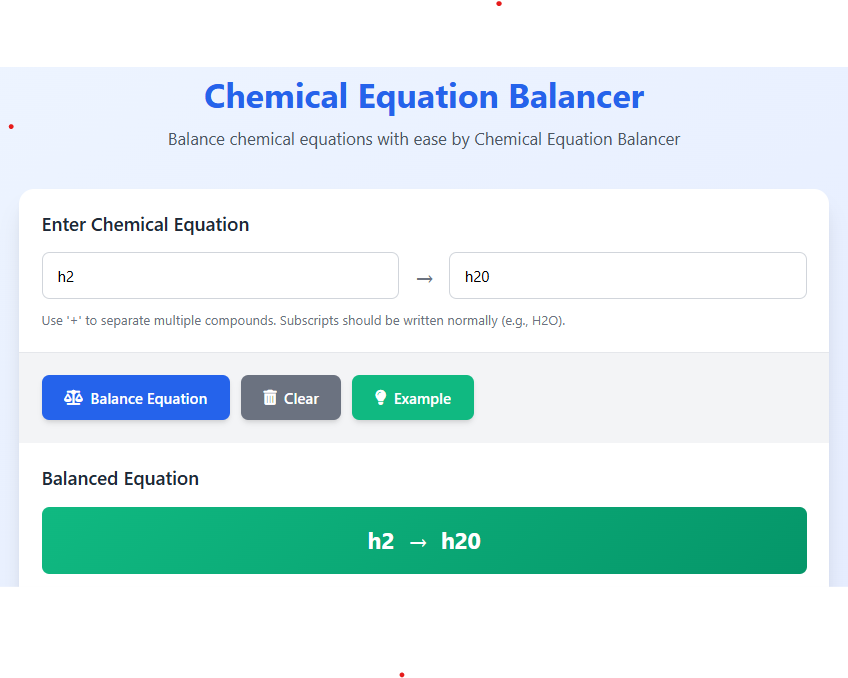Chemical Equation Balancer
Balance chemical equations with ease by Chemical Equation Balancer
Enter Chemical Equation
Use ‘+’ to separate multiple compounds. Subscripts should be written normally (e.g., H2O).
How to Use
1. Enter Equation
Type reactants and products in the input fields
2. Balance
Click the “Balance Equation” button
3. View Results
See the balanced equation with coefficients
About Chemical Equation Balancing
Balancing chemical equations ensures that the same number of atoms of each element are present on both sides of the equation, following the Law of Conservation of Mass.
Why Balance Equations?
- Represents the conservation of atoms in chemical reactions
- Essential for stoichiometric calculations
- Shows the quantitative relationship between reactants and products
- Required for understanding reaction mechanics
Chemical Equation Balancer: Your Science Homework Helper
Have you ever looked at a chemistry problem and felt completely confused? You see something like “H2 + O2 -> H2O” and know it just doesn’t look right. Making sure both sides of a reaction have the same number of atoms is called balancing equations. This task is very important but can also be very tricky. Fortunately, a Chemical Equation Balancer is a smart tool that can help you solve this puzzle quickly and correctly.
First of all, a balanced equation follows the Law of Conservation of Mass. This scientific law states that matter cannot be created or destroyed. Therefore, the number of each type of atom on the left side of the arrow (the reactants) must equal the number on the right side (the products). Consequently, if you see an unequal equation, you know it needs to be fixed.
Chemical Equation Balancer: How It Works Simply
So, how does a Chemical Equation Balancer work its magic? Actually, it uses a powerful mathematical algorithm. You don’t need to know the complex details, however. Primarily, you just type the unbalanced equation into the tool.
For instance, you might type: Fe + O2 -> Fe2O3 (Iron + Oxygen -> Rust).
Then, you press the “Balance” button.
Almost instantly, the tool provides the answer: 4Fe + 3O2 -> 2Fe2O3.
The calculator adds coefficients (the numbers in front) to make the atoms equal on both sides. As a result, you get a perfectly balanced equation without the frustration.
Chemical Equation Balancer: Why It’s a Useful Tool
This amazing tool is helpful for many fantastic reasons. Mainly, it saves you a tremendous amount of time and effort. Additionally, it helps you check your own work for any small mistakes. Moreover, it is an excellent learning aid because you can see the correct balanced result immediately.
Learning and Understanding
You can use this tool to understand how different elements combine. It shows you the precise ratios needed for a reaction to work, which is the core idea of stoichiometry.
Chemical Equation Balancer: A Tool for Everyone
You can use a Equation Balancer calculator for many different tasks. Obviously, it is perfect for students who are just starting to learn about chemistry. Furthermore, professional scientists and teachers also use it to quickly verify their work. It makes a challenging task simple and straightforward for everyone.
In conclusion, a chemical equation balancer is like a helpful tutor available anytime. Ultimately, it turns a difficult problem into an easy solution and helps you learn and succeed in your science studies.

Frequently Asked Questions
Q1: How do I balance a chemical equation with a calculator for complex reactions?
A1: First, you simply input the entire unbalanced equation into the chemical equations balancer. Then, the tool automatically analyzes each element and applies coefficients; however, it may use decimals or fractions for complex stoichiometry. Consequently, it provides a balanced result instantly, so you can focus on understanding the reaction rather than the math.
Q2: Can a chemical equation balancer with steps help me learn the process?
A2: Absolutely! A chemical equation balancers with steps breaks down the process sequentially. First, it identifies unbalanced elements and then shows how coefficients adjust atom counts. Additionally, it explains why specific numbers are chosen, and therefore, it reinforces key stoichiometry concepts for students.
Q3: Why is using a balancing chemical equations calculator important for redox reactions?
A3: Redox reactions involve electron transfer, which often makes manual balancing challenging. A balancing chemical equations calculator handles oxidation number changes effortlessly; meanwhile, it ensures atoms and charges balance simultaneously. Thus, it prevents errors and saves time for both learners and professionals.
Q4: How accurate is a free online chemical equation balancer for homework?
A4: A high-quality free online chemical equation balance is highly accurate for common reactions. However, always double-check rare or complex equations, as some tools may prioritize speed over precision. Nevertheless, most calculators reliably balance equations correctly, making them ideal for homework verification.
Q5: Can this tool balance ionic equations with phases like (aq) or (s)?
A5: Yes, advanced chemical equation balancer tools support ionic equations and phases. First, input the reaction with state symbols (e.g., NaCl(aq) + AgNO3(aq)). Then, the calculator balances atoms and charges; furthermore, it maintains phase notation integrity, ensuring a comprehensive and accurate result.